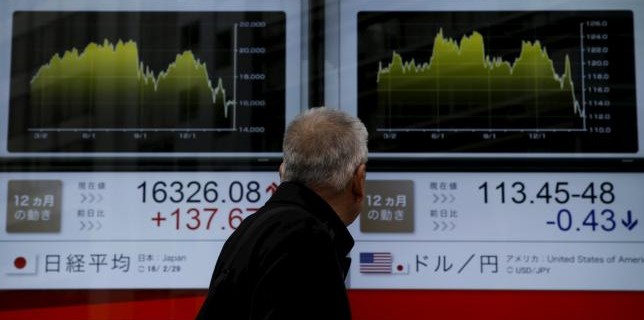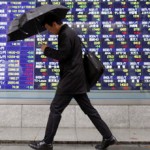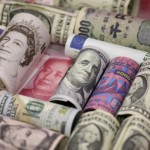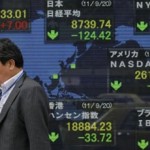Dollar, North Asia stocks firm on positive U.S. GDP data

The dollar firmed on Monday and stocks in North Asia rose after fairly strong consumer spending led to an upward revision in U.S. economic growth in the fourth quarter, helping to underpin investor sentiment.
“As long as the U.S. economic recovery is continuing, I would think the rally in global equity markets will continue,” said Takeru Ogihara, chief strategist at Mizuho Trust Bank.
U.S. stock futures ticked up 0.3 percent, although they remain flat for the quarter.
The dollar index against a basket of six major currencies rose 0.2 percent to 96.378, its highest in almost two weeks. The dollar rose 0.6 percent to 113.64 yen, keeping intact its steady recovery from a 6-1/2-month low of 110.67 hit on March 17.
That gave Japan’s Nikkei a 0.7 percent boost to a 1-1/2-week high.
Shares in Korea were little changed, and Taiwan advanced 0.1 percent, while Chinese stocks added 0.6 percent.
Share markets in Australia, New Zealand and Hong Kong were closed for holidays. That left MSCI’s broadest index of Asia-Pacific shares outside Japan down 0.1 percent, with Southeast Asian markets having a larger-than-usual impact.
Indonesia, Malaysia and the Philippines, which were all trading between 0.2 percent and 0.8 percent lower, while Singapore was little changed.
Gold was also a casualty of the dollar’s strength, with spot gold sliding 0.5 percent to its lowest in a month.
U.S. gross domestic product increased at a 1.4 percent annual rate in Oct-Dec, above the previously reported 1.0 percent pace, the third GDP estimate showed on Friday.
With the U.S. seen as one of the brightest spots in the global economy, signs of resilience there are pivotal to boosting market sentiment.
The euro was little changed at $1.1154, not far from Thursday’s one-week low of $1.1144.
The Australian dollar was steady at $0.7502 having lost 1.4 percent last week and knocked away from an eight-month high of $0.7681.
In the past week, the dollar has been helped by comments from some Fed officials indicating that policymakers think they could raise interest rates as early as next month.
U.S. PCE inflation data due at 1230 GMT could fan expectations of an early rate move if it shows increasing inflationary pressure.
“The PCE inflation has been rising of late. The Fed has said the prices will be the key in determining policy so the data should attract a lot of attention,” said Masahiro Ichikawa, senior strategist at Sumitomo Mitsui Asset Management.
The annual core PCE inflation rose 1.7 percent in January, the fastest pace since July 2014.
The data will be followed by a speech from Federal Reserve Chair Janet Yellen on the economic outlook and monetary policy on Tuesday. A few other Fed policymakers are also due to speak on the same day, making the Fed’s policy the biggest focus for now. [FED/DIARY]
Given that money markets are pricing in only about a 50 percent chance of a rate hike in June, with hardly any significant likelihood in April factored in, signs of a tightening in the next quarter could rattle financial markets.
Oil prices, which have risen about 50 percent since multi-year lows hit in January, extended their gains in thin trading, powered by major producers’ plans to freeze output at January’s highs.
U.S. crude futures gained 0.8 percent to $39.79 per barrel, and Brent advanced 0.8 percent to $40.75.
Source: Reuters





























